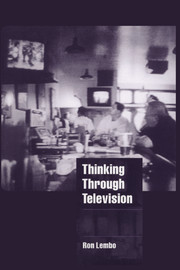Book contents
- Frontmatter
- Contents
- Acknowledgments
- Introduction: Situating my experience with television
- PART I Conceptions of television use
- PART II Reconceptualizing television use
- PART III Documenting the viewing culture
- 6 Methodology and the turn to television
- 7 The practice of viewing
- 8 A typology of television use
- Conclusion: The politics of television reconsidered
- References
- Index
7 - The practice of viewing
Published online by Cambridge University Press: 22 September 2009
- Frontmatter
- Contents
- Acknowledgments
- Introduction: Situating my experience with television
- PART I Conceptions of television use
- PART II Reconceptualizing television use
- PART III Documenting the viewing culture
- 6 Methodology and the turn to television
- 7 The practice of viewing
- 8 A typology of television use
- Conclusion: The politics of television reconsidered
- References
- Index
Summary
This chapter focuses different kinds of viewing relations that typify the experience of those I interviewed and observed. There were two phases of participant observation in my research. The first occurred over a two-year period prior to my conducting depth interviews and did not involve any of the people who participated in the interviews. After initiating contact with a few people who worked at the University of California, I used a “snowball” sampling technique to include friends, acquaintances, and co-workers of those with whom I first watched. I tried to some extent to enlarge my sample, and, frankly, I was limited in doing so. It was difficult to find people who were willing to let me come into the privacy of their homes and just watch television with them. It certainly helped to be “referred” to new people by others that they knew and trusted. Over a period of time, there were eight settings in which I became familiar enough with the people involved to return repeatedly, if not regularly, to “hang out” with them for a while and just watch TV and talk. I supplemented these private observation situations by frequenting various bars and restaurants where at least some of the patrons were attentive to what was on television at least some of the time, and I made it a point to watch one or another “special” sporting event – such as the Super Bowl, the ncaa Basketball Tournament, the nba Playoffs, and so on – in such public settings. The second participant observation phase involved watching television with some of the people that I interviewed. After the interviews were completed, and after telling them of my interest in observing, several of them invited me back to their homes on other occasions, and, as in the first phase, we watched and talked through a typical evening of prime time, or sat and tuned into game shows and the daytime soaps, depending on the situation.
- Type
- Chapter
- Information
- Thinking through Television , pp. 167 - 214Publisher: Cambridge University PressPrint publication year: 2000

